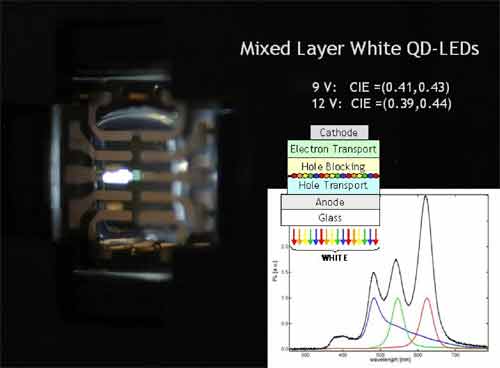 Members of IRG-III of the MIT MRSEC have demonstrated a light emitting device application of such quantum dots. They show that white light can be generated in a layered device that combines organic semiconductor layers with a single monolayer of quantum dots. The composition and the sizes of the quantum dots were chosen to cover the color spectrum required for the perception of white light, as in an incandescent light bulb. The ability to synthesize nanomaterials with nearly atomic precision
Members of IRG-III of the MIT MRSEC have demonstrated a light emitting device application of such quantum dots. They show that white light can be generated in a layered device that combines organic semiconductor layers with a single monolayer of quantum dots. The composition and the sizes of the quantum dots were chosen to cover the color spectrum required for the perception of white light, as in an incandescent light bulb. The ability to synthesize nanomaterials with nearly atomic precision
provides the potential to engineer devices with tailored electronic and
light emitting properties. Nanometer size crystals of semiconductors,
called quantum dots, are especially interesting in that their electronic
properties are strongly dependent on their size. Their size dependent
light emission properties have fascinated chemists, physicists and
engineers for over a decade.
Figure. Schematic illustrates the device architecture, with a quantum dot monolayer sandwiched between organic layers. The blue, green and red spectra in the figure correspond to devices made from the three different types of quantum dots in the white device, and the black spectrum is from the white device itself. The photograph shows an operating device emitting a shade of white that is tuned to match our perception of the color of sunlight.